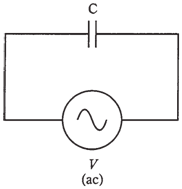Capacitors and alternating current:
Assume that the source is changed from direct to alternating current. Imagine that you can adjust frequency of this alternating current from a low value of a few hertz, to hundreds of hertz, to many kilohertz, and gigahertz.

Figure-- A capacitor across a source of ac.
At first, the voltage between the plates will follow just about exactly along as the ac source polarity reverses over and over. But the set of plates has some amount of capacitance, as you have learned. They can even charge up fast, if they are small and the space in between them is large, but they cannot charge instantaneously.
As you increase frequency of the alternating current voltage source, there will come a point at which plates do not get charged up very much before the source polarity reverses. The set of plates will be sluggish. The charge will not have time to get established with the each alternating current cycle.
At high alternating current frequencies, the voltage between the plates will have trouble following current which is charging and discharging them. As the plates begin to get a good charge, the alternating current will pass its peak and begin to discharge them, pulling electrons out of negative plate and pumping electrons into positive plate.
As frequency is raised, the set of plates starts to behave like more and more like a short circuit. When frequency is low, there is a small charging current, but this rapidly tails off and drops to zero as plates become fully charged. As frequency becomes high, the current flows for more of every cycle before dropping off; the charging time remains constant while period of the charging or discharging wave is getting shorter. Eventually, if you keep on increasing frequency, the period of the wave will be much shorter than charging or discharging time, and current will flow in and out of the plates in just about same way as it would flow if plates were shorted out.
The opposition that the set of plates offers to alternating current is the capacitive reactance. It can be measured in ohms, just like inductive reactance, and like resistance. But it is assigned negative values rather than positive ones. Capacitive reactance, represented by XC, can vary, just as resistance and inductive reactance do, from near zero to the few negative ohms, to many negative kilohms or megohms.
Capacitive reactance varies with the frequency. But XC gets larger as the frequency goes down. This is opposite of what happens with the inductive reactance, which gets larger as the frequency goes up.
At times, capacitive reactance is talked about in the terms of its absolute value, with minus sign removed. Then you can say that XC is increasing as the frequency decreases, or that XC is decreasing as frequency can be raised. It is best, however, if you learn to work with the negative XC values right from the beginning. This will be significant later, when you are required to work with the inductive and capacitive reactance together in same circuits.